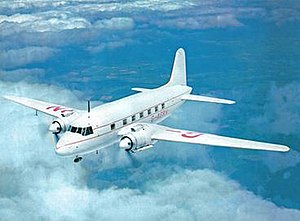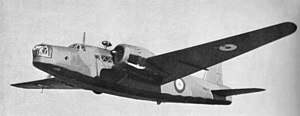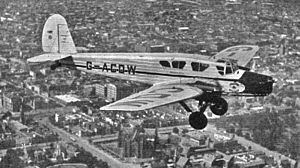BEA Vickers Viking (civilian), Irish Law; RAF de Havilland Devon, Box Law; RAF Vickers Wellington, Box Law; Northern and Scottish Airways Spartan Cruiser (civilian), West Girt Hill; crash dates 21/04/48, 03/06/58, 21/01/41 & 14/01/38
[Pictures from wikipedia.org]




OS 10-figure grid refs (GPS):
Viking:
NS 26077 59182 (main debris site)
NS 26019 59227 (propellor)
NS 25952 59222 (propellor)
NS 26154 59230 (tail section)Devon:
NS 26040 60875
NS 25889 60923
NS 25838 60775 (main debris site)Wellington:
NS 25657 60922Cruiser:
NS 27034 62538Google Maps display showing wreckage locations This relatively small area (only about 4km across) of the high featureless moorland of the Muirshiel Hills east of Largs contains wreckage sites from four military and civilian aircraft crashes that happened over a twenty-year period from 1938 to 1958. There have been several crashes in this area over the years, and some information about this can be seen here.
The sites of the Devon & Wellington crashes are only about 200m apart, whilst the site of the Viking crash lies about 2km south from these two sites. The site of the Cruiser crash is about 2km to the northeast.
Viking:
The crash site of the Vickers Viking lies at an altitude of about 440m, very close to the 484m summit of Irish Law, about 150m north of the trig point on the summit. All of the five crew and sixteen passengers on the Viking survived the crash.
Some large pieces of wreckage remain at the site and most of this wreckage lies in a shallow crater where the Viking ended up after crashing. In this crater lie the remains of the two Bristol Hercules engines, one of which is largely intact and which is still attached to the wing-mounted engine nacelle which also contains one of the undercarriage mechanisms with a tyre and wheel still attached (3rd and 4th photos of the Viking below).
About 100m east of the crater lies a section of the tail (8th photo of the Viking below), and about 75m and 125 to the west of the crater lie the two propellor hubs (1st and 2nd photos of the Viking below).
The Vickers Viking was developed from the Vickers Wellington bomber and it is possible to see similarities between this wreckage and that of Wellingtons, particularly in some sections of geodetic framework.
There are excellent views from all of these sites westwards to Arran and the Firth of Clyde. From the summit of Irish Law, it is also possible to see the wreckage of the de Havilland Devon.
The ACSS website has some pictures of this wreck site and information about the crash here.
Devon:
The crash site of the de Havilland Devon lies at an altitude of about 450m, close to the 474m summit of Box Law. There are a few pieces of twisted metal lying in various places in the marshy ground but most of the wreckage lies in a single area - this area of wreckage is fairly unusual in that the general outline of the aircraft can still be discerned in the placement of the wings, engines and tailplane (5th photo of the Devon below).
Both Gipsy Queen engines lie at the wreck site (8th and 9th photos of the Devon below), and the undercarriage is still visible protruding from the upside-down wings. The registration number, VP969, of the Devon is still just about visible on the wings (7th and 10th photos of the Devon below).
The ACSS website has some pictures of this wreck site and information about the crash here.
At the National Museum of Flight, East Fortune, there is a de Havilland Dove (the civilian version of the Devon) on display (photo below).
Wellington:
The crash site of the Wellington is a single small debris field very close to the Devon wreckage, consisting of small pieces of mangled wreckage. A gear assembly is recognisable as well a small part of the distinctive geodetic airframe of the Wellington.
The ACSS website has some pictures of this wreck site and information about the crash here.
Cruiser:
There are only a few small remaining pieces of the wreckage of Northern and Scottish Airways Spartan Cruiser, about 100m south of the summit of West Girt Hill at an altitude of about 510m (3rd and 5th photos of the Cruiser below). Some small wood sections of the aircraft have remained at the site since it crashed in 1938, over 75 years ago.
Personal correspondence from Gary Nelson has confimed that the wreckage is that of the Cruiser and he sent me two photos of the wreck that were taken very shortly after the crash, which show that it was fairly intact when it crashed (1st and 2nd photos of the Cruiser below). Gary has compared the hills on the skyline (circled in red) in the 2nd photo to a photo he took at the site recently (3rd photo of the Cruiser below) to confirm that the wreckage is indeed from the Spartan.
The main fuselage section from the crashed Cruiser can be seen at the National Museum of Flight, at East Fortune (4th photo of the Cruiser below). Some information about the crash and more photos of this fuselage section can be seen here. The ACSS website has some information about the crash and some pictures of the retrieval of the fuselage section (which took place in 1973) here.
These pictures were taken in November 2011.
Viking:
 |
 |
 |
 |
 |
 |
 |
 |
These pictures were taken in May 2013.
Devon:
 |
 |
 |
 |
 |
 |
 |
 |
 |
 |
National Museum of Flight, East Fortune.

|
These pictures were taken in May 2013.
Wellington:
 |
 |
 |
 |
Cruiser:
 |
 |
 |
 |
 |